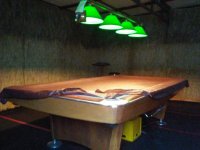bhayhurst
New member
For people who practice on terrible tables and compete on nice ones, or pros that have to play in a ton of different environments: how do you deal with it?
I just moved to a new city, and in the part of the city where I live (South Side / Southern 'burbs), the pool halls are terrible. Bad... everything. Cloth. Rails. Balls. Dirt.
On the North side of the city, there are some really nice pool halls. Well maintained tables, beautiful. It's a pool-playin' town! (Note: I'm not gonna say what large American city I'm talking about -- let you figure it out?)
It's way too long of a drive to go to the nicer halls to practice, so I'm forced to run drills on the lesser tables near me. Tournaments (and my once-a-week 14.1 league) are, of course, in the nicer halls. Therefore, I practice on crappy tables and compete on nice tables, and it's killing me -- my speed control is wrecked; I hit the ball way too hard. My draw/follow is out of touch, etc. (We've all played on crappy tables -- y'all get the picture.)
With all that said, here's my question:
For people who practice on terrible tables and compete on nice ones, or pros that have to play in a ton of different environments: how do you deal with it? Do you have a method to get wired-in on speed control and amount of spin? If so... what is it?
I'm imagining something along the lines of this:
When I start on the table before the tournament, I do the following shots to determine the speed of the table: shot a, b..., shot e. The way that I score the speed: if 100% is how hard I hit the ball on my practice table, what percent do I have to hit to get the same results on this table? Then I do these shots to determine the qualities of the rails...
Pros have to have some methodology in this regard, right?
I just moved to a new city, and in the part of the city where I live (South Side / Southern 'burbs), the pool halls are terrible. Bad... everything. Cloth. Rails. Balls. Dirt.
On the North side of the city, there are some really nice pool halls. Well maintained tables, beautiful. It's a pool-playin' town! (Note: I'm not gonna say what large American city I'm talking about -- let you figure it out?)
It's way too long of a drive to go to the nicer halls to practice, so I'm forced to run drills on the lesser tables near me. Tournaments (and my once-a-week 14.1 league) are, of course, in the nicer halls. Therefore, I practice on crappy tables and compete on nice tables, and it's killing me -- my speed control is wrecked; I hit the ball way too hard. My draw/follow is out of touch, etc. (We've all played on crappy tables -- y'all get the picture.)
With all that said, here's my question:
For people who practice on terrible tables and compete on nice ones, or pros that have to play in a ton of different environments: how do you deal with it? Do you have a method to get wired-in on speed control and amount of spin? If so... what is it?
I'm imagining something along the lines of this:
When I start on the table before the tournament, I do the following shots to determine the speed of the table: shot a, b..., shot e. The way that I score the speed: if 100% is how hard I hit the ball on my practice table, what percent do I have to hit to get the same results on this table? Then I do these shots to determine the qualities of the rails...
Pros have to have some methodology in this regard, right?
